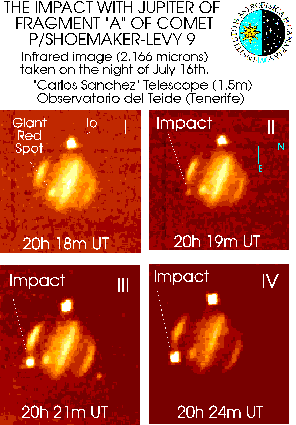

NOTE: Click on the image to view it at its highest resolution.
At 20:18UT (Canary Islands, 22:18CET) a spot was detected on Jupiter in the position corresponding to the impact site of the first fragment of the comet (Nucleus A or 21). This observation was made by astronomers at the Instituto de Astrofisica de Canarias (IAC) with the 1.5m Carlos Sanchez, infrared telescope and with the 82cm IAC-80 Telescope, both in Teide Observatory (Tenerife). The detection was first made in the infrared and then, later, in the visible. According to the Central Bureau for Astronomical Telegrams of the IAU, this was the first report received of a detection of the impact from anywhere in the world.
The spot was extraordinarily bright, slightly less than the sateillite Io in the infrared and was between 20 and 30 thousand kilometers in length, rather larger than the Great Red Spot.
The bright spot was very short lived: after 15 minutes, two of the three telescopes had virtually lost it from view. However, two hours later, a very faint cloud was still visible, a remenant of the explosion. This spot moved across the disk much more slowly than the visible cloud features, demonstrating that it is in the stratosphere of the planet, well above the visible clouds.
The observations appear to suggest that a bubble of hot gas formed above the impact site, but that the gas was not hot enough to emit significantly in the visible, emitting mainly in the infrared range. Shortly after appearing, the gas cooled and ceased emitting strongly in the infrared. The faint spot that has been seen since appears to be a cloud that has formed at very high altitude. the delay in the movement of the spot with respect to the Great Red Spot which was simultaneously visible in the disk indicates that the rotation of the upper atmosphere of Jupiter is very slow compared to the lower levels.
Members of observation team, all from Instituto de Astrofisica
de Canarias:
P. Hammersly, M. Serra-Ricart,
I. Vidal, J.M. Rodriguez-Espinosa, P.L. Palle, M. Kidger, J.J. Fuensalida
The images taken in the infrared band are accesibles via anonymous FTP at internet node iac.es in the directory pub/jupiter. The composition of images is the GIF file j16col1.gif.